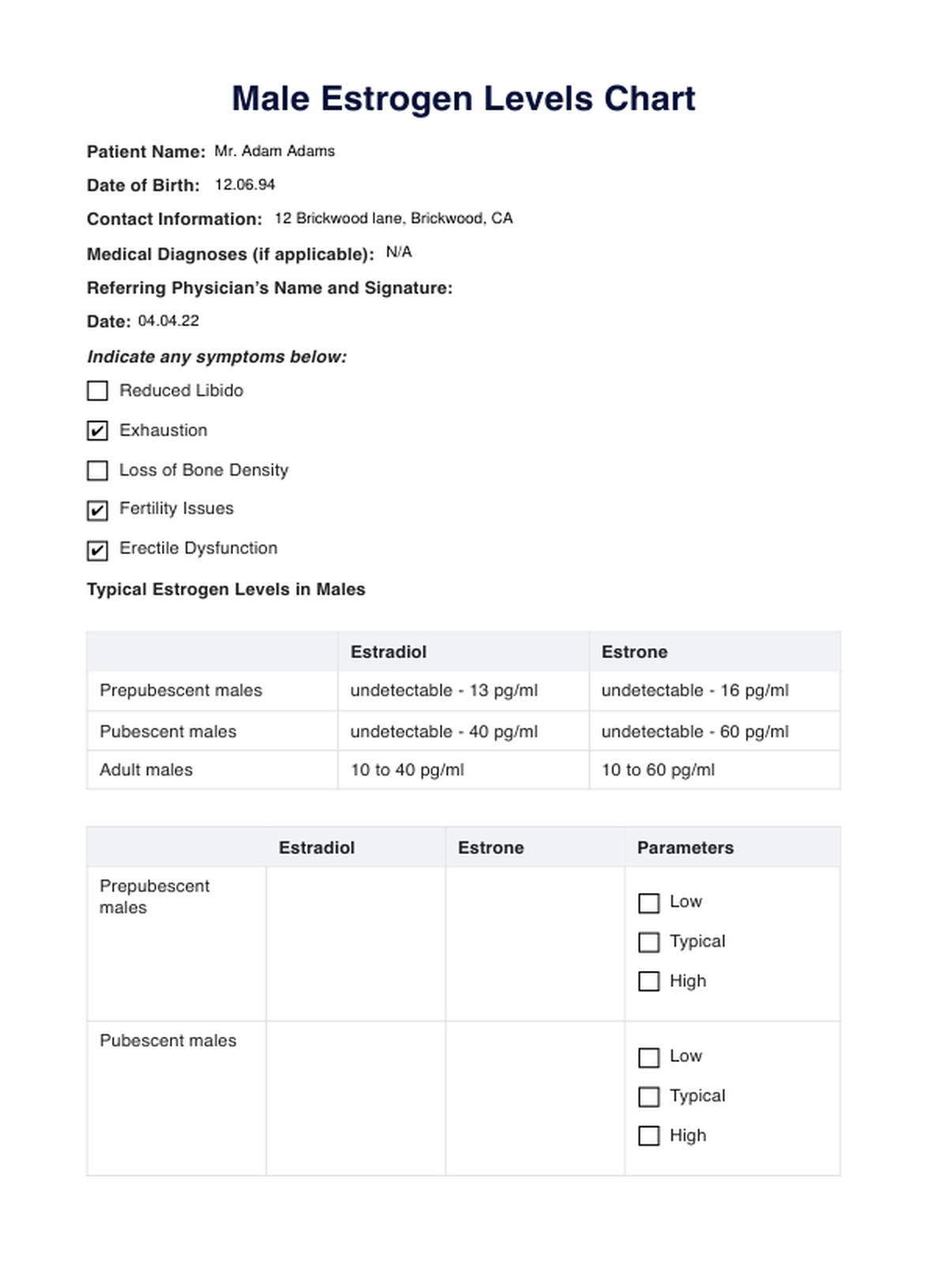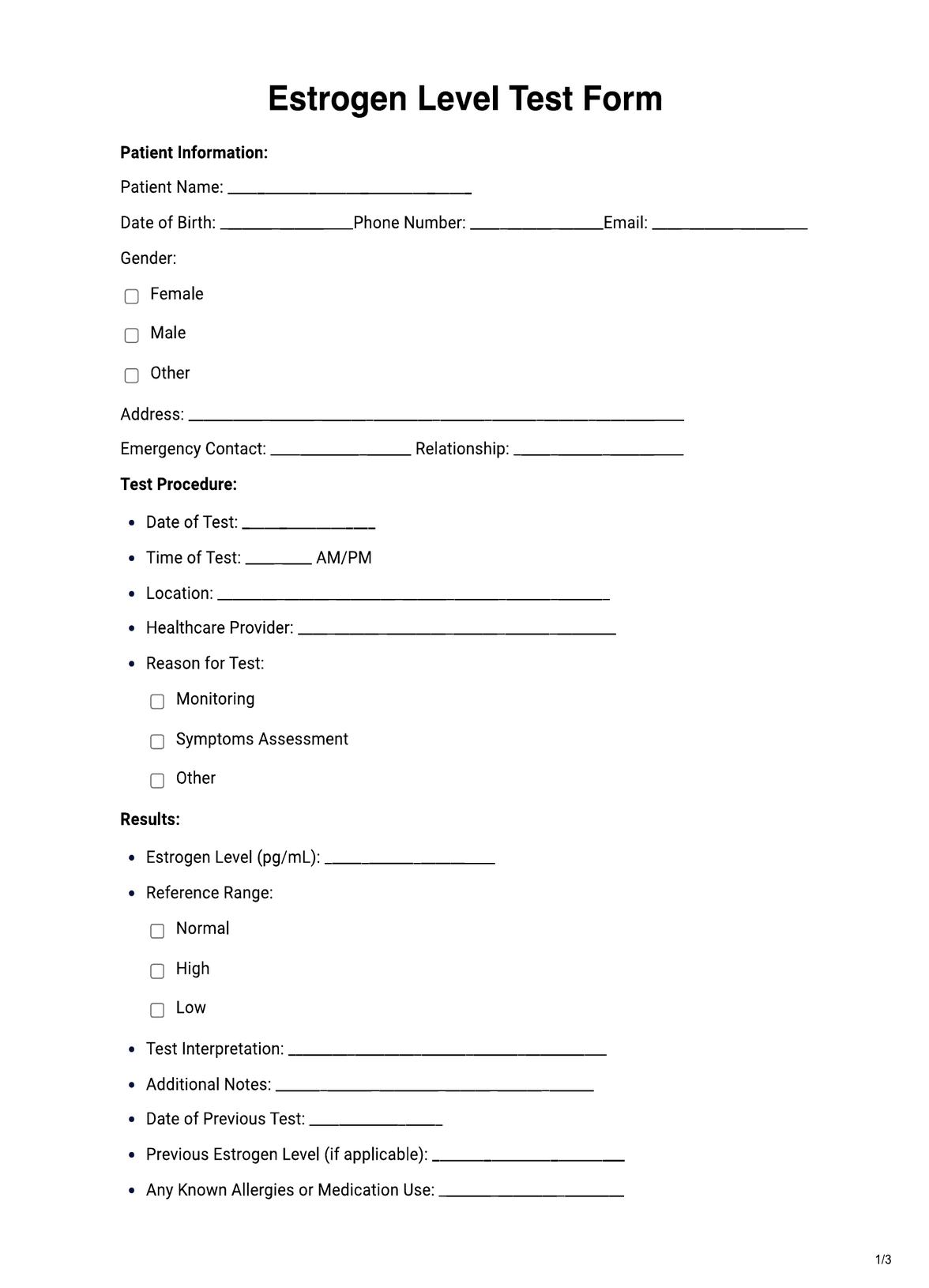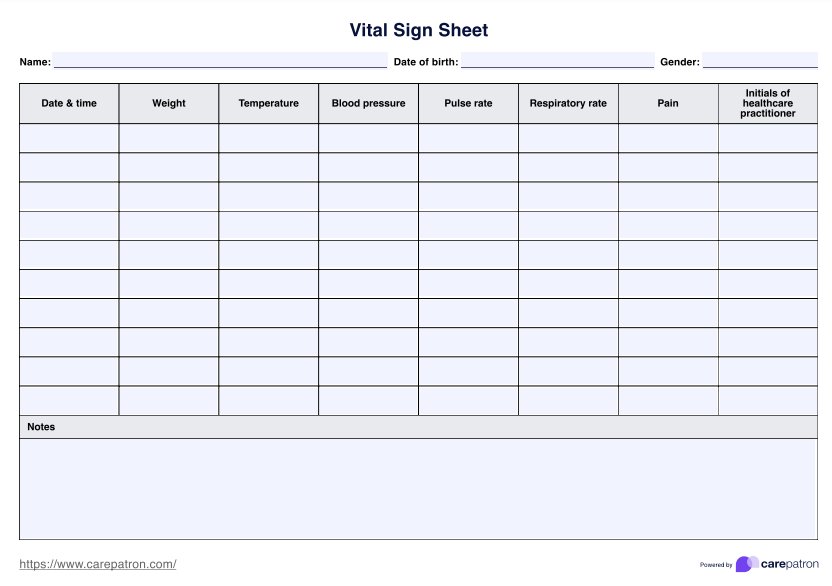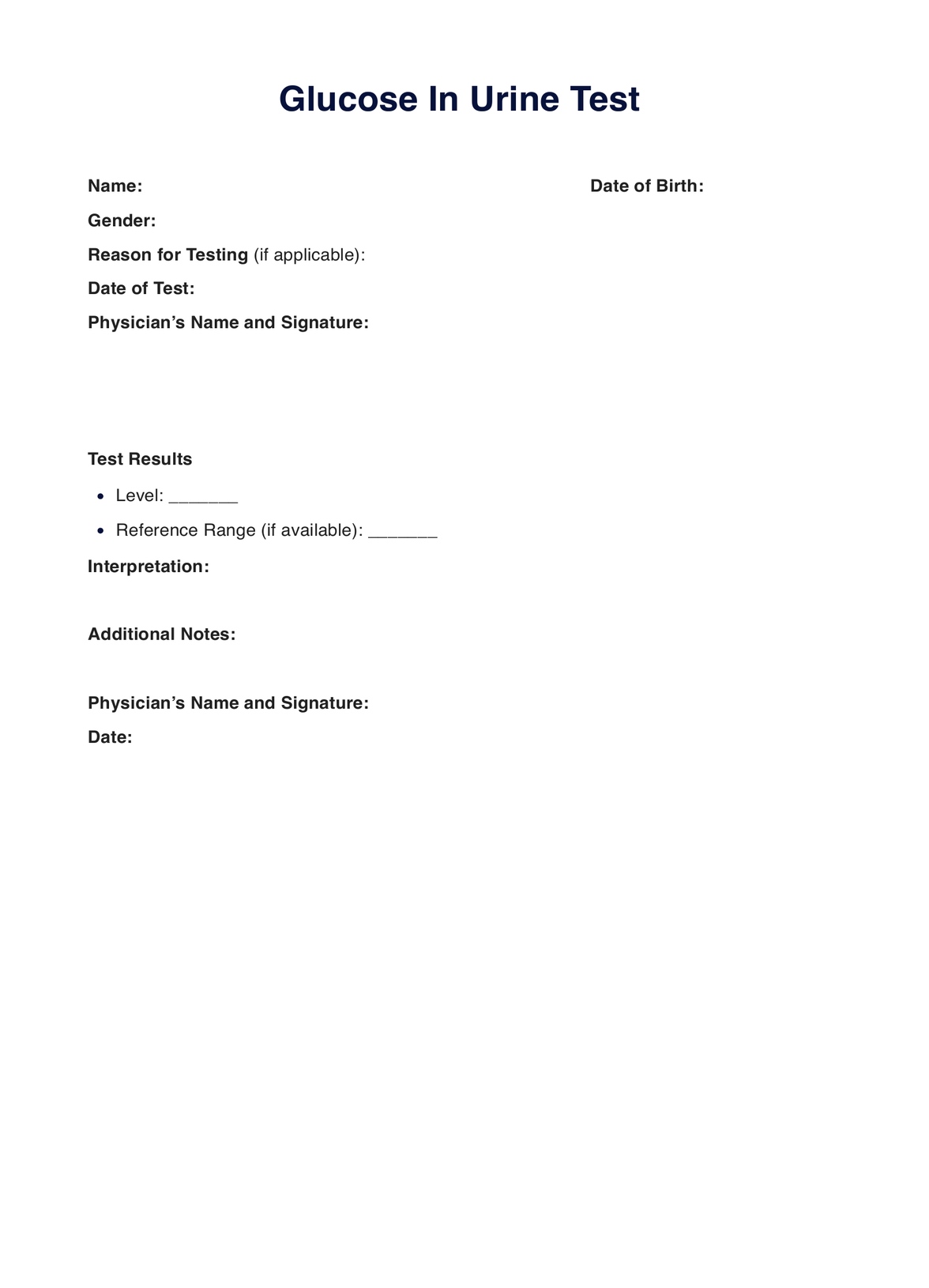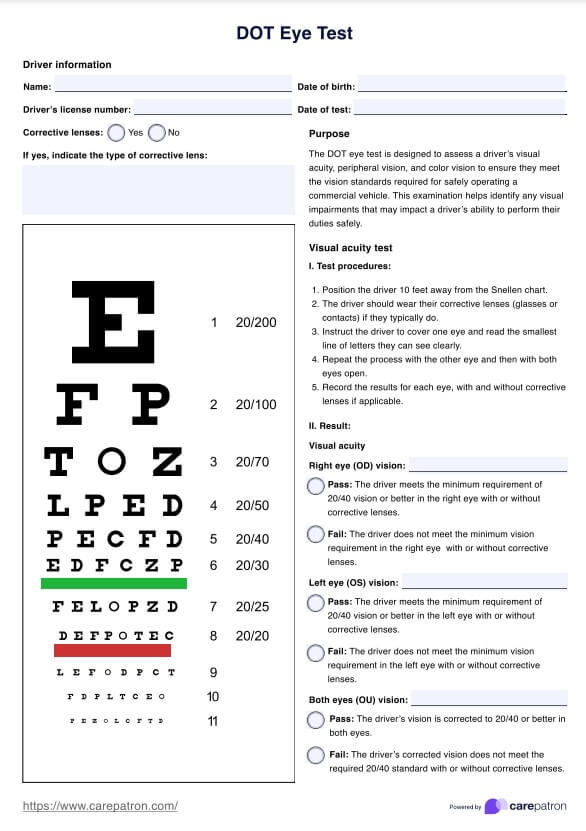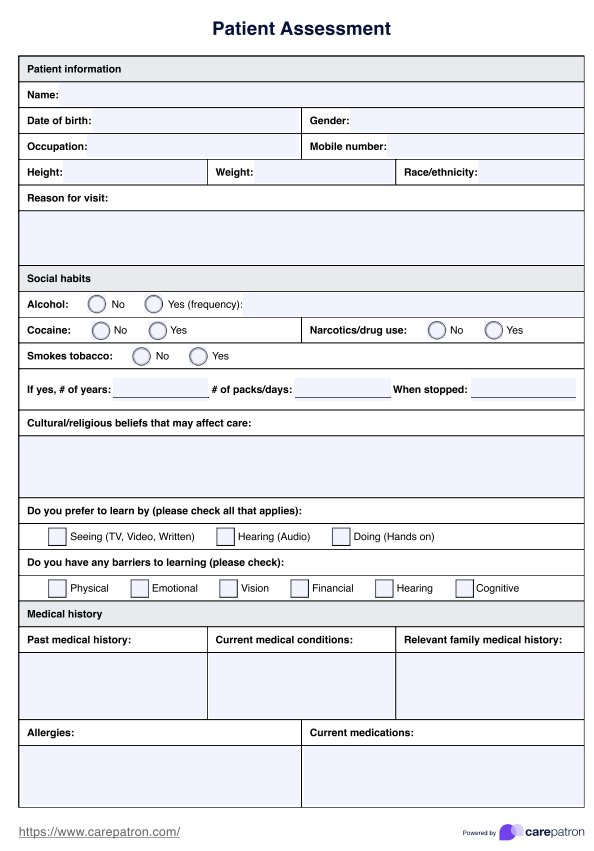Male Estrogen Levels
Have this easy-to-use male estrogen levels chart on hand for clear analysis and interpretation of your patient's estrogen level results. With an array of symptom options and included parameters, identification of hormonal imbalance has never been easier!


What is a Male Estrogen Levels Chart?
A estrogen levels test can help assist healthcare professionals with the deciphering of hormonal imbalances and recording results against recommended parameters. A Make Estrogen Levels Chart can be handy during the test.
Although typically referred to as a female sex hormone, estrogen is also present and crucial in male hormone levels. Concise charting and recording of this hormonal level can help target imbalances and maintain bone density, sexual health, and cardiovascular health.
Testosterone is the most prevalent hormone contributing to male sexual function and development. Yet, it needs to remain balanced with estrogen, or more specifically estradiol, to help keep human body functions well maintained and healthy.
Estradiol (E2) is a critical player in the modulation of sperm cell production, male libido, and erectile dysfunction; therefore, a male estrogen levels chart can offer a great deal of insight into distressing symptoms that your patient may be experiencing.
The male estrogen levels chart delineates the established parameters of estrone and estradiol, providing a comprehensive overview that evolves with age to mirror fluctuations in testosterone levels during puberty and adulthood.
This chart serves as a valuable tool for identifying imbalances in sex hormones, including instances of too much estrogen or fluctuating testosterone levels. Medical professionals can use this chart to delve into the root causes with their patients.
In this diagnostic process, it's crucial to consider risk factors such as current antibiotic or herbal remedy use, underlying health issues like diabetes and autoimmune conditions, and kidney disorders. By incorporating these elements, healthcare providers can gain a more nuanced understanding of the intricate interplay between sex hormones and male reproductive function.
Male Estrogen Levels Template
Male Estrogen Levels Example
How does it work?
Step 1: Gather your resources
An easy-to-access and user-friendly chart for recording and analyzing male estrogen levels is key in any healthcare practice. Ensure you have your free printable male estrogen levels chart on hand by simply clicking the “Download Template” button or keyword search “male estrogen levels chart” on the extensive database in Carepatron's template library.
Step 2: Gather and collate essential information
Fill in the patient's key details, relevant medical history, and symptoms that may have led to the request for an estrogen levels test. This will be through a hematology outlet. In the appropriate sections, fill in the results for estradiol and estrone.
For clear cross-analysis of the recommended parameters, ensure these levels are in pictogram per milliliter (pg/ml).
Step 3: Compare results and identify imbalances
Once the chart is filled out, a clear picture will be formed of the status of the male patient's estrogen levels. By comparing the results to the easily accessed parameters, a distinction can be made between low, normal, or high levels of estrogen present.
Interpreting the results is key for highlighting the need for intervention moving forward. Conveniently store notes on the further steps taken within the same chart or Carepatron's centralized workspace.
Step 4: Store the template securely
After reviewing the results and hosting a consultation with your patient, you need to secure the template so that access is only granted to relevant parties.
When would you use this Chart?
A male estrogen levels chart is a well-utilized and valuable tool used in various medical contexts to help diagnose and establish normal estrogen ranges for the respective age groups. This tool is invaluable in the following contexts:
Diagnosing
Medical teams can view the estrogen levels chart tailored to males to diagnose conditions relevant to both high and low estrogen levels, notably infertility, gynecomastia, erectile dysfunction, and, in some cases, tumors.
This tool is a great way to address the symptom concerns relating to hormonal imbalance, as there is a specific section dedicated to common issues linked to high and low estrogen levels unique to male patients.
Monitoring
Along with assisting with the diagnosis, the male estrogen levels chart can assist patients in the continued monitoring their estrogen levels should their results be of concern. The chart can be an effective monitoring tool to evaluate the effectiveness of estrogen-related interventions such as aromatase inhibitors or diet and lifestyle changes.
Education
This resource is beneficial in the education of hormonal activity in men. This chart can display the lows or highs in the patient's levels and link the common symptoms to the imbalances. This is a fantastic resource to use in conjunction with testosterone level testing to gain a clearer picture of the hormonal cycle of males.
What do the results mean?
Once you have the patient's estrogen level information in your free Male Estrogen Levels Chart, analysis can be completed against the typical and expected estrogen parameters.
- In prepubescent male, estrogen levels are considered normal if: Estrone is undetectable to 16 pg/ml and estradiol is undetectable to 13 pg/ml.
- In pubescent male, estrogen levels are considered normal if: Estrone is undetectable to 60 pg/ml and estradiol is undetectable to 40 pg/ml.
- In adult male, estrogen levels are considered normal if: Estrone sits between 10 to 60 pg/ml and estradiol sits between 10 to 40 pg/ml.
Low estrogen levels
If a male presents with low levels of estrogen, the concern is low. However, further investigation may be needed to rule out hypogonadism. This particular condition inhibits hormone production in the body and may lower other vital hormones like testosterone. It presents itself with similar symptoms as high estrogen levels.
Low estrogen levels due to hypogonadism may be caused by: autoimmune disease, sexual organ infection, kidney or liver conditions, non-descending testicles, hemochromatosis, radiation, HIV, pituitary gland issues, and rapid weight loss or gain.
High estrogen levels
If a male presents with levels of estrogen above the parameters, there is a need for further intervention to address concerns around sexual development and function. Some symptoms of high estrogen levels include infertility, gynecomastia, depression, and erectile dysfunction.
The increase in estrogen levels may be caused by testosterone supplementation, diabetes, testicular or adrenal tumors, hyperthyroidism, or insulin resistance.
Management of estrogen levels
Some diet and lifestyle changes can be considered in managing estrogen levels. Reduction in alcohol consumption to lower estrogen levels, as well as a diet low in fat and high in fiber, is desirable. Foods high in estrogen-blocking phytochemicals like pomegranates are also natural ways to lower levels.
Some work has been done around the use of aromatase inhibitors and the enzyme's ability to turn androgens into estrogen, yet the effects are minimal. For low estrogen levels causing severe imbalance, hormone replacement therapy may be viable.
Research & evidence
From what has been historically considered a female hormone, the importance of estrogen in males and its presence has been known for nearly 100 years. Initially believed to cause harm should it be present in males, the important hormone is now well-researched and known to be a vital part of normal male functioning.
The 1990s saw a paradigm shift in the understanding of estrogen function within the biological male through thorough testing that revealed estrogen's main receptor is vital and essential for male fertility and development (Hess & Cooke, 2018). This same study showed that even a tiny imbalance could have detrimental effects and holds the risk of inducing extensive male reproductive abnormalities and infertility.
Seeking estrogen level testing should be a routine and accessible way of addressing concerns for male patients. The evidence for estrogen management and harmony in the female body is well known; the same emphasis should be placed on male levels.
The enzyme aromatase can convert testosterone into estradiol, a key hormonal component for the regulation of sex drive, erections, sperm production, and testicular function. Besides these essential functions, estrogen helps control cholesterol levels and maintain bone and heart health.
Having a hormonal balance in the male body is paramount and has been highlighted by multiple studies through the connection between low testosterone and estrogen.
A correlation is formed because the required levels of estradiol in males are made from testosterone. If the patient lacks testosterone, it lacks the fundamental building blocks needed to create more estradiol, creating a loop of imbalance. Charting for this is again highlighted as an essential and valuable addition to medical screening.
References
Healthline. (2019, October 22). Estrogen in Men: How It Works and What High or Low Levels Mean. Healthline. https://www.healthline.com/health/estrogen-in-men#treatment
Hess, R. A., & Cooke, P. S. (2018). Estrogen in the male: a historical perspective. Biology of Reproduction, 99(1), 27–44. https://doi.org/10.1093/biolre/ioy043
LLC, H. io. (n.d.). Estrogens, Total (male) | Healthmatters.io. Healthmatters.io. https://healthmatters.io/understand-blood-test-results/estrogens-total-male
Medical News Today. (2020, November 9). Estrogen in men: Symptoms of high and low levels, and more. Www.medicalnewstoday.com. https://www.medicalnewstoday.com/articles/estrogen-in-men#lowering-estrogen-levels
White, W. J. (2019, April 4). The Importance of Estrogen (Estradiol) in Men's Health. Testosterone Centers of Texas. https://tctmed.com/estrogen-in-men/
Commonly asked questions
Primary care physicians and specialists like endocrinologists will typically utilize a male estrogen levels chart.
Male estrogen level charts are used when the medical specialist wishes to analyze and investigate the estradiol and estrone levels in male patients and compare them against normal estrogen parameters.
Our male estrogen level chart template is a multi-faceted tool. It can be used as a reference, an educational aid for patients, and a key document for recording results and notes on the male patient.
Our easy-to-use charting tool takes 10 to 15 minutes to complete with relevant blood results available and can provide a comprehensive overview in just minutes.



